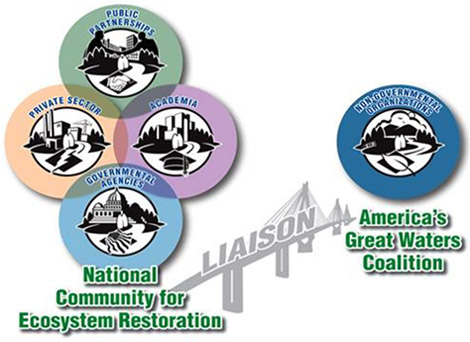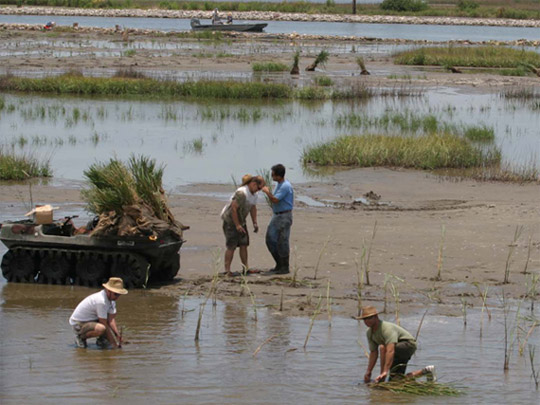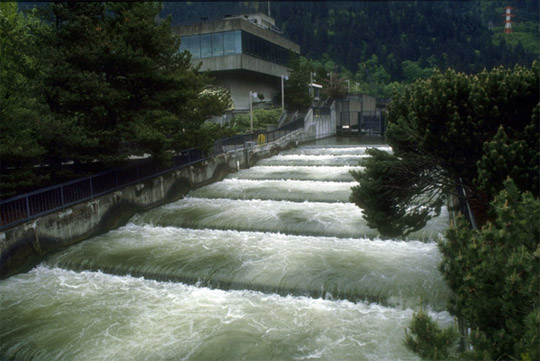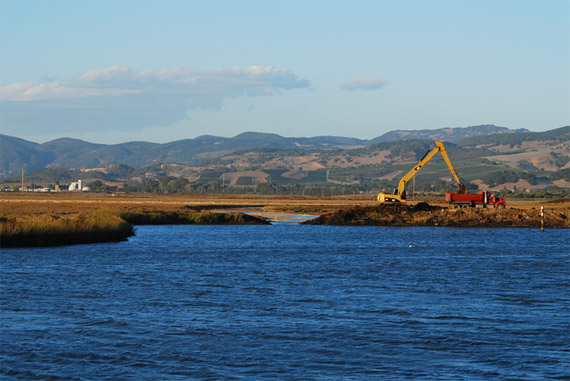Taking Ecosystem Restoration to the Next Level
Ecosystem restoration has become a dominant activity for many natural resource management agencies throughout the United States and the world. Although it is now one of the fastest growing fields, large-scale ecosystem restoration is a significant challenge. A recent Northeast-Midwest Institute report identified four challenges for such large-scale projects:
- These ecosystems are immense and complex. Restoration efforts must bring together interests with little in common – sometimes from hundreds of miles away and across state boundaries in many cases – to solve problems.
- These efforts must decide what “restoration” is. Is it improving the ecosystem’s health and/or resiliency? Or, is it restoring the ecosystem to its historical condition?
- Natural resource managers must achieve restoration in light of significant scientific uncertainty, which is exploited by detractors and makes restoration more difficult.
- Restoration is expensive, and its funding stream is unpredictable.
The sum of these large-scale ecosystem restoration efforts is greater than its parts, but they are an unfocused force. Within the U.S., 10 federally sponsored large-scale ecosystem restoration efforts currently exist, which are spread throughout the country. Some are decades old while other are just a few years old. Together these ecosystems are located in 27 of 50 U.S. states and are home to nearly one-half of America’s population. This represents many people and voters as well as, potentially, a large voting bloc in Congress. Therefore, these issues are of national significance, especially since the health of these ecosystems defines the health and economy of the nation.
NCER’s Historical Background
Thanks to the wisdom and perseverance of G. Ronnie Best, Ph.D. and United States Geological Survey Coordinator, Greater Everglades Priority Ecosystems Science, the first National Conference on Ecosystem Restoration took place in Orlando, Fla. in 2004. It became a biennial event in 2007 in Kansas City, Mo. and subsequently occurred in 2009 in Los Angeles, Calif. (http://conference.ifas.ufl.edu/ncer/). Increasing in size every year, the 2011 nationwide event in Baltimore, Md., brought together nearly 1,000 scientists, engineers, policy makers, planners and partners each of whom are actively involved in ecosystem restoration. This interdisciplinary conference presents state-of-the art science and engineering, planning and policy in a partnership environment. Both the National Research Council (NRC) and the U.S. Army Corps of Engineers (USACE) Environmental Advisory Board emphasize the need for leadership in the ecosystem restoration arena in order to achieve success. As such, attendees at past conferences have requested some form of collaboration to bridge the biennial events.
The concept of a National Community for Ecosystem Restoration (NCER) was initially launched at the 2009 National Conference for Ecosystem Restoration. At that event, two feedback forums were convened: a leadership summit and a closing plenary session. In addition, a questionnaire was distributed to conference attendees in order to obtain their input. The NCER concept was also presented at the November 2009 Annual American Water Resources Conference and the 2010 Greater Everglades Ecosystem Restoration Conference.
Along a parallel but uncoordinated path, America’s Great Waters Coalition (AGWC), a non-governmental organization, officially “launched” December 2009 at the U.S. Capitol Visitor Center. According to AGWC, it is “an alliance of national, regional, state and local organizations working to protect, preserve and restore America’s Great Waters. The coalition is a result of years of work by national and local organizations to bring the broader restoration community together to ‘raise all boats.’” The organization works to secure needed long-term federal funding commitments and comprehensive policy for sound restoration of many of America’s large aquatic ecosystems. Upon coordination with AGWC, a draft conceptual model for NCER was created, which will complement and not duplicate this organization’s efforts:

Photo Courtesy Weston Solutions, Inc.
NCER’s top two goals are as follows:
- Link all ongoing ecosystem restoration efforts and fill recognized knowledge transfer and communication gaps, and
- Help enable a collaborative and holistic life-cycle approach to ecosystem restoration.
Since NCER 2009 approximately 50 volunteers, who are national senior leaders in the field of ecosystem restoration, have been working diligently to take this group to the next level. These leaders created Mission, Implementation and Governance sub-teams and are actively pursuing the organization’s next steps thru its mission statement and focus.
Mission: NCER will serve as a leading information transfer forum for large-scale ecosystem restoration programs as well as related programs across the United States. The organization will provide assistance to those implementing ecosystem restoration programs by bringing together diverse science, engineering and social science disciplines to foster knowledge exchange, policy development and partnerships.
Focus:
- Enhance technical tools (analytical tools and modeling, technology supporting monitoring and research, and standards and guidelines for restoration);
- Support policy, planning and science (setting objectives and measures of success, advancing approaches to science learning, communicating ecosystem restoration goals and developing policy at the national level), and
- Develop partnerships and networks (through the biennial conference, semi-annual newsletter, roster of experts, and partnership opportunities between federal and state agencies, private entities, NGOs and stakeholders).
SER’s Historical Background
The Society for Ecological Restoration (SER) is a non-profit international organization dedicated to advancing the field of ecological restoration. For the past 25 years, it has been promoting ecological restoration as a discipline that can provide practical solutions to many environmental challenges. SER’s vision, mission and guiding principles are as follows:
Vision: Ecological restoration is widely and effectively implemented to successfully re-establish and enhance biodiversity, ecosystem services and human well-being. SER fulfills its mission through its role as a leading global network that advances the science and practice of ecological restoration worldwide.
Mission: SER promotes ecological restoration as a means of sustaining the diversity of life on Earth and reestablishing an ecologically healthy relationship between nature and culture.
Guiding Principles:
- Knowledge and Practice Based – Successful ecological restoration requires integration of knowledge and practice. Science, other forms of knowledge and related disciplines are essential for designing, implementing and monitoring restoration projects and programs. At the same time, lessons learned from practical experiences are essential for determining and prioritizing scientific needs of the field.
- Engaging and Collaborative – Ecological restoration is an inclusive process that embraces interrelationships between nature and culture, engages all sectors of society, and enables full and effective participation of indigenous and local communities.
- Policy Relevant and Essential – Ecological restoration is essential for achieving biodiversity conservation, climate change adaptation and mitigation, ecosystem service provisioning, connection of people with nature, socioeconomic development and improvement of human well-being.
- Locally Practiced with Global Implications – Ecological restoration takes place in all regions of the world with local actions having regional and global benefits for nature and people.
SER has given voice to the field of ecological restoration and has become recognized as a leader of this emerging discipline. Its members have helped develop solutions to the many challenges facing people in the new millennium. SER has members in more than 50 countries with 12 established chapters, and two more are being formed.
In addition to communicating leading-edge technologies and new scientific findings, SER promotes best restoration practices worldwide. The organization continues to increase its influence by establishing regional chapters, hosting biannual conferences and advising international organizations on policy and legislation. It also maintains online networks, including the Global Restoration Network (GRN) and Indigenous Peoples’ Restoration Network (IPRN). SER’s publications include: Restoration Ecology, a peer-reviewed journal; The Science and Practice of Ecological Restoration, an extensive book series published in collaboration with Island Press and affiliated journals Ecological Restoration and Ecological Management & Restoration.

Photo Credit: NOAA|Volunteers plant a salt marsh in Louisiana as part of the Edward Wisner Donation Marsh Restoration Project after the Deepwater Horizon oil spill.
Should NCER & SER Join Forces?
In September 2010, NCER representatives were invited to meet with SER’s Board. The two entities agreed to prepare a white paper, for consideration by both memberships, detailing the pros and cons of the organizations’ joining. At the August 2011 National Conference on Ecosystem Restoration a plenary forum presented the proposed merger along with another option – incorporation as a standalone 501(c)(3) professional society. In addition, a keynote speaker from SER, Keith Bowers, FASLA, RLA, PWS (Biohabitats, Inc.), provided information on the organization, its mission and actions. Questionnaires were distributed to conference attendees and emails sent to attendees from all previous conferences. Of the questionnaires returned, 75 percent supported the continued exploration of an SER merger.
The proposed merger would:
- Provide NCER with an organizational structure to advance ecosystem restoration more effectively;
- Expand SER’s capacity to more fully represent the array of restoration practitioners;
- Advance the science and practice of large scale ecosystem restoration more effectively across the United States and internationally;
- Enhance SER’s and NCER’s capacities to support the community of ecosystem restoration practitioners, researchers and educators;
- Strengthen a diverse coalition of science, engineering and social science disciplines related to restoration and foster knowledge exchange and strategic partnerships;
- Unite and strengthen the “voice” of the restoration community to more effectively facilitate policy changes, minimize duplication of efforts and maximize financial resources; and
- Enhance/strengthen capacity to advocate for policies and regulations that support ecological/ecosystem restoration.
The SER/NCER Proposal
The SER/NCER proposal includes the following:
- The NCER biennial conference would serve as the SER U.S. National/North American conference. Although SER recognizes and fully supports that the NCER conference focus is to further the agenda and aspirations of NCER’s mission and goals, the U.S. national conference should also serve to further SER’s agenda and aspirations while providing U.S. and North American SER members the opportunity to meet.
- The establishment of a guild or other such entity within SER to represent the NCER constituency. SER welcomes working with the NCER constituency to structure an entity within its organization that supports NCER’s mission to serve as a leading information-transfer forum for large-scale ecosystem restoration programs and related programs nationwide. While NCER’s current focus is U.S. ecosystem restoration, it seeks opportunities to expand worldwide. SER, in consultation with NCER constituency leadership, will amend its bylaws and develop a mutually acceptable brand name to accommodate a NCER guild or other entity.
- Access to the Global Restoration Network (GRN), which offers the field of ecological restoration a new web-based database portal to access technically sound and hard-to-find information on all aspects of restoration. This ranges from historic ecosystems and causes of degradation to in-depth case studies and descriptions of proven restoration methods and techniques. SER invites the NCER constituency to collaborate on expanding and enhancing GRN to incorporate information, resources and projects pertaining to large ecosystem restoration initiatives.
- SER is forming the Society for Ecological Restoration Practitioners Institute (SERPI), a 501(c)(6) subsidiary. To date, an ad-hoc committee has completed the first draft of a certification program design, which is being vetted by committee members and outside consultants. Ecological restoration is now recognized worldwide as an important approach for the recovery of impaired ecosystems, including their biodiversity, ability to provide natural goods and services, and capacity to provide sustainable livelihoods. Demand is increasing for qualified professionals with the skills, knowledge, experience and ability to plan, design, implement, maintain, monitor, manage and evaluate restoration projects.
- Discounts on subscription and conference rates, as well as a free subscription to RESTORE and SERNews. SER invites the NCER constituency to help shape the editorial content of many of these publications (or develop new publications) to incorporate issues associated with large-scale ecosystem restoration.
- SER invites NCER constituency to collaborate in crafting revisions for the SER Primer on Ecological Restoration and other foundation documents to ensure the representation of large-scale ecosystem restoration. SER recognizes that its journal Restoration Ecology and, to a large degree, Ecological Restoration are not meeting the needs of ecological restoration practitioners. As a result, SER is considering creating a publication focusing exclusively on the practice of ecological restoration at scales ranging from regional and ecosystem to site-specific, addressing social and economic issues, and providing on-the-ground solutions to all aspects of restoration. SER welcomes the opportunity to collaborate with NCER constituency to develop this type publication.
Potential Advantages of Joining Forces
Merging NCER with SER would provide both groups with a unified, more powerful, more effective voice in advancing the practice of ecological/ecosystem restoration. The organizations share common goals and objectives and are supported by a diverse group of individuals representing a variety of disciplines. These groups share an interest in advancing the science and practice of ecosystem restoration throughout the U.S. and around the globe. The potential advantages of the merger include the following:
- Focus on NCER efforts to develop resources, technical tools and methodologies needed to advance the practice of ecological/ecosystem restoration,
- Strengthen the organizations’ mutual capacity to share information,
- Broaden the network of restoration practitioners,
- Expand and strengthen inter-institutional partnership opportunities (e.g., public, private and non-profit sectors),
- Improve capacity to bring ecological/ecosystem restoration to the forefront of the environmental agenda,
- Enrich/diversify the dialogue among restoration practitioners and scientists,
- Present a united front to promote restoration,
- Provide SER and NCER with a unified platform and a stronger voice,
- Assist NCER in formalizing its institutional presence.

Photo Credit: NOAA|One main concern for the Lower Columbia River is fish passage blockage by dams and essential fish habitat conservation for key fisheries. The area also includes many communities susceptible to climate change effects, which are exacerbated by reduced shoreline resiliency resulting from shoreline hardening and estuary ecosystem degradation.
Potential Concerns of Joining Forces
During discussions regarding the merger, the potential for the following concerns surfaced. Specifically,
- Some NCER participants expressed doubt in the ability of the SER guild structure to meet NCER needs;
- Some NCER participants believe the name “Society for Ecological Restoration” does not accurately portray NCER’s work or mission;
- A perception exists that SER is a research-oriented society with a membership comprised largely of academics/researchers focused on restoration ecology “theory;” whereas NCER participants are more diverse, interdisciplinary and focused on ecosystem restoration “implementation.”
The Way Forward
It is time to decide the governance path to pursue for NCER, which consists of the following three options:
- One option is to continue the biannual NCER meetings, which has been done since Best organized the first conference in 2004. However, this provides no framework for continued dialogue between conferences and no organizational structure for this important group of ecosystem practitioners.
- Another option is for NCER constituents to self-organize as a standalone professional organization. This approach is more grassroots-oriented and would require dedicated volunteers from its constituency to make this a reality. However, it would provide the continuity and structure desired by many NCER constituents.
- Finally, NCER can join forces with SER, an established professional organization with similar goals and objectives. This option provides constituents who attend NCER meetings the continuity and structural framework they are seeking while also broadening SER’s scope and horizon. This third option is currently being pursued.
Large-scale ecosystem restoration is an issue of vital national importance. The health and condition of ecosystems form the foundation of America’s future not only with respect to preservation of these natural treasures but also in terms of its economy and the livelihood of generations to come. Meaningful change through implementation of large-scale ecosystem restoration programs requires adaptive learning, high-quality interpersonal connections, enterprise energy, explicit alignment and generative leadership. Deciding the health of its ecosystems is a defining moment for the U.S. Leaving a legacy through leadership and partnership is possible, but the time to act is now!
If you would like to join this very important initiative, please contact the author, Cheryl Ulrich, at cheryl.ulrich@westonsolutions.com.

Photo Credit: NOAA|NOAA will potentially be part of a collaborative interagency effort to promote a healthy, sustainable San Francisco Bay Delta ecosystem. This will provide California with a high-quality, reliable and sustainable long-term water supply and will restore the system’s environmental integrity and sustainability.




























